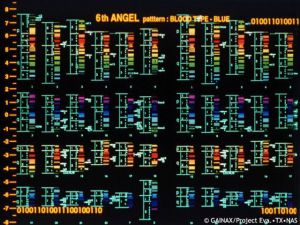Particle-Wave Matter: Difference between revisions
(What's puzzling you, is the nature of my game...) |
No edit summary |
||
| Line 1: | Line 1: | ||
[[Image:OP C076 big.jpg|thumb]] | [[Image:OP C076 big.jpg|thumb]] | ||
"Particle-wave matter" is the unidentified substance that [[Angels]] (and thus, the [[Evangelions]]) are composed of. It is not simply an unknown chemical substance: the basic atomic structure of the matter Angels are composed of is different from anything previously encountered by human science. | "'''Particle-wave matter'''" is the unidentified substance that [[Angels]] (and thus, the [[Evangelions]]) are composed of. It is not simply an unknown chemical substance: the basic atomic structure of the matter Angels are composed of is different from anything previously encountered by human science. | ||
As Dr. [[Ritsuko Akagi]] explains in [[Episode 05]] after analysis of the corpse of the Angel [[Shamshel]]: | As Dr. [[Ritsuko Akagi]] explains in [[Episode 05]] after analysis of the corpse of the Angel [[Shamshel]]: | ||
Revision as of 22:03, 20 August 2007

"Particle-wave matter" is the unidentified substance that Angels (and thus, the Evangelions) are composed of. It is not simply an unknown chemical substance: the basic atomic structure of the matter Angels are composed of is different from anything previously encountered by human science.
As Dr. Ritsuko Akagi explains in Episode 05 after analysis of the corpse of the Angel Shamshel:
- "We do know the Angel is composed of a type of matter characterized by both particulate and wave properties, like light."
Essentially, Matter tends to behave as particles (discrete individual units), while Energy (all electromagnetic radiation including light) behaves as waves (waves of energy). However, Einstein won the Nobel Prize for proving that Energy behaves as both waves and particles. The basic units of Energy are "photons", discrete packets of Energy which cannot be further subdivided. Later, it was discovered that Matter actually behaves as waves too: according to the Heisenberg Uncertainty Principle, electrons move around an atom in such a way that while a discrete "particle", the exact location and direction of a single electron cannot be determined at the same time (this is why the "cloud" model is often used to represent electrons), and they do behave like a wave. Later, it was discovered that Protons and Neutrons also behave somewhat like a wave, but their motion is incredibly small and negligible, due to their much greater mass than electrons (one proton has well over a thousand times greater mass than an electron). Photons apparently have no mass (though it might just be so small that scientific instruments cannot detect it).
Wave-particle duality can basically be thought of on this spectrum: Proton --> Electron -----> Photon
- Proton: heavy mass = behaves almost entirely like a particle, with negligible wave properties
- Electron: small mass = behaves mostly like a particle, but has distinct wave-like behavior
- Photon: no (or almost) no mass = behaves like a wave, with particle-properties in that it cannot be infinitely subdivided into smaller units.
The "particle-wave matter" that Angels (and Evas) are composed of would, based on Ritsuko's description, appear to be somewhere on the spectrum between Electrons and Photons: it's not quite what we'd strictly define as "Matter" and not quite what we'd strictly define as "Energy", but falls between the two. It has significant mass, but more photon-like wave-behavior than electrons. The result would look like: Proton --> Electron --> "Particle-wave matter" --> Photons
Notes
- The exact term "particle-wave matter" was never used in the series as an exact term; the name for this article is based on the quote from Ritsuko in Episode 05.
- Wave-particle duality is a real-world scientific principle.
This article bears the unpleasant designation of "Stub." This is a Bad Thing. Provide a great service to NGE fan-geeks everywhere by making it awesomer!
